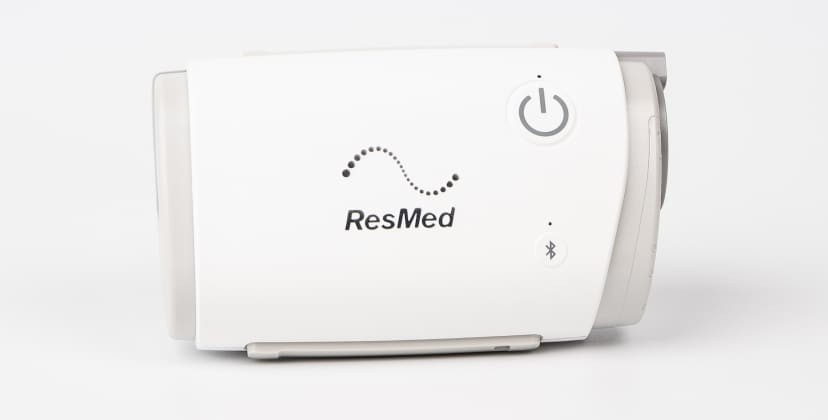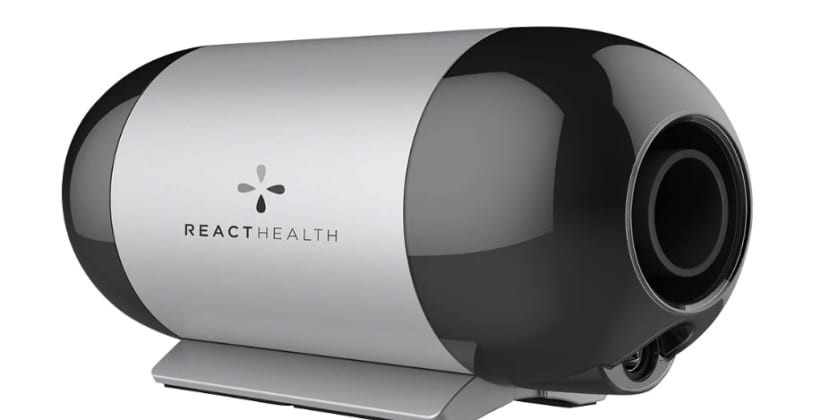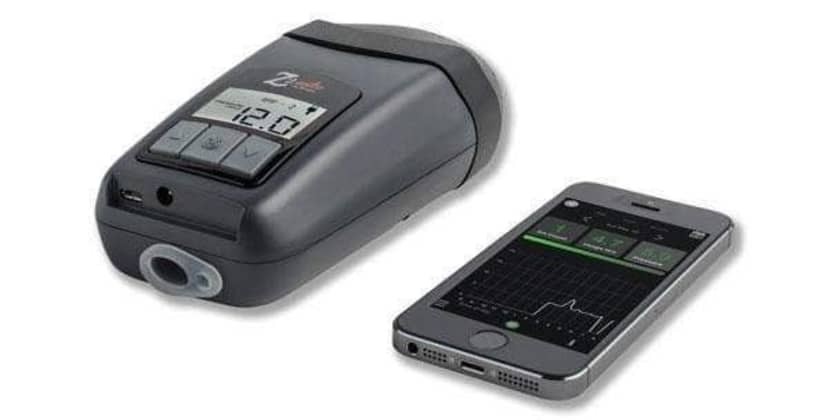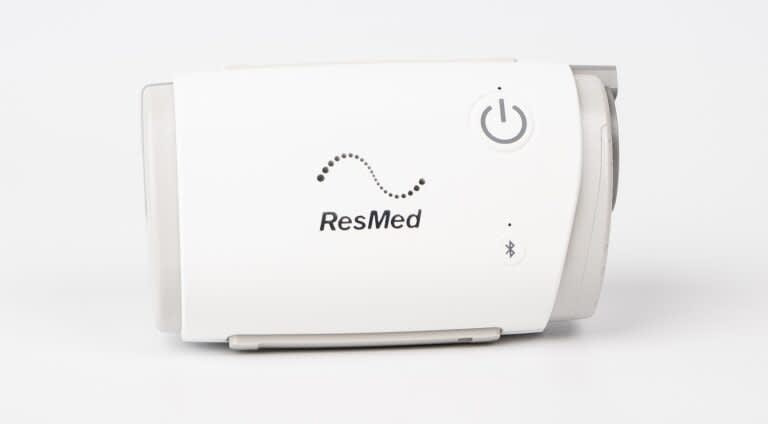Choosing a travel CPAP machine ensures you maintain consistent sleep apnea therapy while exploring stunning destinations like Vietnam. SIXT.VN provides seamless travel solutions, including comfortable airport transfers and hotel bookings, so you can focus on enjoying your trip. Proper research and planning are key to a hassle-free experience, ensuring your sleep therapy isn’t compromised during your travels, especially with services like reliable transport options and hotel stays coordinated by SIXT.VN.
1. What Are The Best Travel CPAP Machines Available?
The best travel CPAP machines are ResMed AirMini, Luna TravelPAP, Transcend Micro Auto-CPAP Machine, and Breas Z2 Auto CPAP Machine. These models are compact, lightweight, and equipped with features tailored for travel.
1.1. ResMed AirMini
The ResMed AirMini stands out with its small size and efficient design, making it ideal for travelers.
- Features: Compact design, FAA-approved, auto-adjusting pressure, and smartphone app for data tracking.
- Benefits: Quiet operation, waterless humidification (HumidX), and compatibility with various ResMed masks.
- Use Cases: Business trips, camping, and airplane travel.
- Price: Approximately $1,008.
 ResMed AirMini travel CPAP machine showcasing its compact design and suitability for travel
ResMed AirMini travel CPAP machine showcasing its compact design and suitability for travel
1.2. Luna TravelPAP
The Luna TravelPAP is perfect for users needing high-pressure levels with its auto-ramp feature for comfortable use.
- Features: Auto-ramp, FAA-compliant, and LightTrip Mobile App for sleep data.
- Benefits: Adjusts pressure for altitude changes, no need for distilled water, and suitable for long flights.
- Use Cases: Travelers requiring high-pressure settings and those on long flights.
- Price: Approximately $1,365.
 Luna TravelPAP designed for high-pressure CPAP therapy while traveling
Luna TravelPAP designed for high-pressure CPAP therapy while traveling
1.3. Transcend Micro Auto-CPAP Machine
The Transcend Micro Auto-CPAP Machine is lightweight and compact, ideal for frequent travelers.
- Features: Automatic pressure adjustment, drying mode, and suitable for altitudes up to 8,000 feet.
- Benefits: Affordable, lightweight, and perfect for both home and travel use.
- Use Cases: Frequent travelers needing a compact and efficient CPAP machine.
- Price: Approximately $999.
 Transcend Micro Auto-CPAP Machine, a lightweight and compact solution for travelers needing CPAP therapy
Transcend Micro Auto-CPAP Machine, a lightweight and compact solution for travelers needing CPAP therapy
1.4. Breas Z2 Auto CPAP Machine
The Breas Z2 Auto CPAP Machine offers both CPAP and APAP therapy options in a lightweight design.
- Features: Auto-adjusting pressure, Z-Breathe feature, auto start/stop, and optional PowerShell for battery use.
- Benefits: Quiet motor, FAA-compliant, and suitable for off-grid travel.
- Use Cases: Travelers needing flexible therapy options and those traveling to remote locations.
- Price: Approximately $899.
 Breas Z2 Auto CPAP Machine offering versatile CPAP and APAP therapy for travelers
Breas Z2 Auto CPAP Machine offering versatile CPAP and APAP therapy for travelers
2. Why Should I Consider Using A Portable CPAP Machine While Traveling in Vietnam?
Using a portable CPAP machine ensures consistent sleep apnea therapy, which can greatly impact your overall health and enjoyment of your trip, especially when navigating different environments in Vietnam. Portable CPAP machines are typically smaller than standard at-home models and include features like waterless humidifiers for easier use on the go.
2.1. Health Benefits
Consistent CPAP therapy helps maintain stable health, preventing sleep apnea-related issues that could disrupt your travel plans.
2.2. Convenience
These machines are designed for travel, making them easy to pack and use in different locations, whether you’re in a hotel in Hanoi or a remote village.
2.3. Features
Many models come with travel-friendly features like waterless humidification, reducing the need for distilled water and additional accessories.
2.4. Limitations
Portable CPAP devices are not intended for long-term use and should not replace your home CPAP machine for everyday therapy. They can also be expensive and may not be covered by insurance. It’s important to ensure they work with your existing accessories.
3. What Factors Should I Consider When Choosing A Travel CPAP Machine?
When selecting a travel CPAP machine, consider machine type, pressure range, noise level, features, technology, and warranties. Consulting with your doctor can help you find a device compatible with your therapy settings and address any comfort issues that may arise.
3.1. Machine Type
Consider whether you need a standard CPAP or an APAP machine. APAP machines adjust pressure based on your breathing patterns, which can be beneficial for some users.
- CPAP (Continuous Positive Airway Pressure): Delivers air at a constant, fixed pressure throughout the night. This is the traditional type of machine and requires a prescription setting determined by a sleep study.
- APAP (Automatic Positive Airway Pressure): Automatically adjusts the pressure based on the user’s breathing patterns. This type of machine can be more comfortable for some users as it provides the minimum pressure needed at any given time.
3.2. Pressure Range And Noise Level
Ensure the machine can handle the pressure range prescribed by your doctor, typically between 4 and 20 cm H2O. Look for a quiet device, aiming for a noise level of less than 30 decibels.
3.3. Features and Technology
Look for features like data tracking via smartphone apps, pressure ramping, and heated tubing.
- Data Tracking: Allows users to monitor their therapy progress and meet insurance requirements. The data is typically displayed in a smartphone app.
- Pressure Ramping: Starts therapy at a lower pressure and gradually increases it as you fall asleep, making it easier to acclimate to the machine.
- Heated Tubing: Prevents condensation from forming in the hose if you use a humidifier.
3.4. Recalls and Warranties
Check for warranty coverage and stay updated on any product recalls to ensure your safety and protection against defects. According to research from the U.S. Food and Drug Administration in 2021, recalls are crucial for identifying and rectifying potentially dangerous medical devices.
3.5. Portability
Consider the size and weight of the machine, especially if you plan to travel frequently. Compact and lightweight models are easier to pack and carry.
3.6. Power Supply
Check the power requirements of the machine and whether it is compatible with the voltage in the countries you plan to visit. You may need an adapter or converter.
4. What Accessories Are Available For Travel CPAP Machines Suitable For Travel In Vietnam?
Accessories for travel CPAP machines include CPAP masks, tubing, air filters, external batteries, waterless humidifiers, and travel bags. Verify compatibility with your machine before purchasing any accessories.
4.1. Essential Accessories
- CPAP Mask: Ensure your mask is comfortable and fits well.
- Tubing: Slim tubing is easier to pack.
- Air Filters: Keep your air clean and machine functioning efficiently.
4.2. Travel-Specific Accessories
- External Batteries: Essential for camping or areas with limited electricity. Lithium-ion batteries are commonly used.
- Waterless Humidifiers: Heat and moisture exchangers (HME) recycle moisture from exhaled air.
- Travel Bag: Helps keep all accessories together in one place.
According to a study by the American Thoracic Society in 2022, using appropriate accessories can significantly improve the comfort and effectiveness of CPAP therapy.
5. Where Can I Buy A Travel CPAP Machine?
Travel CPAP machines are available through online retailers, brick-and-mortar stores, and sleep clinics. Ensure you purchase from an authorized medical equipment provider with a prescription.
5.1. Online Stores
Generally offer a greater selection and lower prices.
5.2. Brick-And-Mortar Stores
Allow you to see the machine in person before buying.
5.3. Sleep Clinics
Provide expert advice and support.
5.4. Pricing And Insurance Coverage
The average cost ranges from $800 to $1,200. Check with your insurance carrier for coverage details, as policies may vary. For instance, Medicare typically covers replacement machines only if the original is lost, stolen, damaged, or more than 5 years old, as detailed in the Medicare Coverage of DME and Other Devices publication in 2023.
6. What Are Some Essential Tips For Traveling With A CPAP Machine In Vietnam?
When traveling with a CPAP machine, it’s easiest to use a smaller CPAP machine and bring accessories such as a travel bag, CPAP wipes, portable batteries, and a waterless humidifier. Depending on your mode of transport, different factors need to be considered.
6.1. Flying With A CPAP Machine
In the U.S., CPAP machines can be carried on airplanes and do not count toward luggage allowance if packed in a separate bag, according to the Transportation Security Administration (TSA).
 Carrying a CPAP machine on an airplane, ensuring sleep apnea therapy is maintained while flying
Carrying a CPAP machine on an airplane, ensuring sleep apnea therapy is maintained while flying
- Preparation: Empty your humidifier’s water chamber and bring distilled water in checked baggage or small carry-on bottles.
- Security: Remove the machine from its bag for X-ray scanning and place it in a clear plastic bag. Bring your prescription or a doctor’s note.
- In-Flight Use: Provide a certificate of FAA approval. Check with the airline beforehand and avoid using the humidifier during the flight.
- International Travel: Verify compatibility with foreign power outlets and bring an adapter. Keep a copy of your prescription.
6.2. Camping With A CPAP Machine
Ensure access to a power supply using electrical hookups, inverters, or portable battery packs. Check the machine’s maximum operating altitude.
6.3. Cleaning And Care
Clean the mask and tubing connector daily using warm water, mild soap, and a soft brush. Wipe down the machine and soak the tubing weekly. Replace waterless humidifiers and disposable filters regularly.
7. How Do I Clean And Maintain My Travel CPAP Machine During My Trip To Vietnam?
Cleaning a portable CPAP machine is similar to cleaning a regular CPAP machine. However, if you’re using your CPAP machine while on a plane or when camping, you may need to pack CPAP wipes, distilled water, or other cleaning supplies.
7.1. Daily Cleaning
- Mask and Tubing Connector: Clean daily with warm water, mild soap, and a soft brush.
- Procedure: Disassemble the machine, unplug it, and remove the waterless humidifier and sound muffler (if applicable). Clean the mask and tubing connector daily using warm water, mild soap, and a soft brush. Rinse thoroughly and air dry.
7.2. Weekly Cleaning
- Machine and Tubing: Wipe down the machine and soak and clean the tubing weekly.
- Procedure: Wipe down the machine with a damp cloth. Soak the tubing in warm, soapy water for about 30 minutes, then rinse thoroughly and air dry.
7.3. Replacement
- Waterless Humidifiers and Filters: Replace waterless humidifiers and disposable filters regularly.
- Damaged Parts: Replace any parts that are cracked or damaged immediately.
7.4. Additional Tips
- CPAP Wipes: Pack CPAP wipes for quick cleaning on the go.
- Distilled Water: If using a humidifier, ensure you have access to distilled water.
- User Guide: Always check the user guide for instructions specific to your machine.
Following these cleaning and maintenance tips will help ensure your travel CPAP machine remains in good working condition throughout your trip.
8. What Are Common Issues Encountered While Using A Travel CPAP Machine And How To Troubleshoot Them?
When using a travel CPAP machine, common issues include mask leaks, dry nose or throat, condensation in the tubing, and power supply problems. Troubleshooting these issues can ensure your therapy remains effective and comfortable.
8.1. Mask Leaks
- Problem: Air leaking from the mask, reducing therapy effectiveness.
- Solution:
- Adjust Mask: Ensure the mask is properly fitted and adjusted.
- Clean Mask: Clean the mask to ensure a good seal.
- Replace Cushion: If the mask cushion is worn, replace it.
- Use Mask Liners: Consider using mask liners for a better seal.
8.2. Dry Nose Or Throat
- Problem: Dryness due to lack of humidity.
- Solution:
- Use Humidifier: If possible, use a humidifier with your travel CPAP machine.
- Waterless Humidifier: Opt for a waterless humidifier (HME).
- Nasal Saline: Use nasal saline sprays to keep your nasal passages moist.
- Lower Pressure: Lower the CPAP pressure if dryness persists.
8.3. Condensation In The Tubing (Rainout)
- Problem: Moisture buildup in the tubing, causing gurgling noises and potential discomfort.
- Solution:
- Heated Tubing: Use heated tubing to maintain consistent temperature.
- Tube Cozy: Wrap the tubing in a cloth cover to insulate it.
- Lower Humidity: Reduce the humidifier setting.
- Elevate Machine: Place the CPAP machine lower than your head to allow water to drain back into the humidifier.
8.4. Power Supply Problems
- Problem: Machine not turning on or losing power.
- Solution:
- Check Connections: Ensure all power connections are secure.
- Use Adapter/Converter: Use the correct adapter or converter for international travel.
- Test Outlet: Test the outlet with another device to ensure it is working.
- Battery Backup: Use a battery backup if power outages are common.
8.5. Machine Noise
- Problem: Excessive noise from the machine, disturbing sleep.
- Solution:
- Place On Soft Surface: Place the machine on a soft surface to reduce vibrations.
- Check Filters: Ensure the air filters are clean and not clogged.
- Inspect Machine: Inspect the machine for any loose parts or damage.
8.6. Altitude Adjustments
- Problem: Difficulty breathing at high altitudes.
- Solution:
- Automatic Adjustment: Ensure your machine has automatic altitude adjustment.
- Manual Adjustment: If necessary, manually adjust the pressure settings as recommended by your doctor.
8.7. Data Tracking Issues
- Problem: Inaccurate or missing data on your smartphone app.
- Solution:
- Check Connection: Ensure the machine is properly connected to your smartphone.
- Update App: Update the app to the latest version.
- Contact Support: Contact the manufacturer’s support for assistance.
By addressing these common issues and implementing the suggested solutions, you can ensure a comfortable and effective CPAP therapy experience while traveling.
9. Are There Any Specific Considerations For Using A Travel CPAP Machine In Vietnam Due To Climate Or Infrastructure?
When using a travel CPAP machine in Vietnam, consider the climate, which can be hot and humid, and the infrastructure, which may have unreliable power supplies. Addressing these factors will help ensure your therapy is effective and comfortable.
9.1. Climate Considerations
- Humidity:
- Issue: High humidity can lead to increased condensation in the CPAP tubing, known as “rainout.”
- Solutions:
- Heated Tubing: Use heated tubing to maintain a consistent temperature and reduce condensation.
- Tube Cozy: Wrap the tubing in a cloth cover to insulate it and prevent condensation.
- Waterless Humidifier: Opt for a waterless humidifier (HME) to avoid issues with distilled water and condensation.
- Lower Humidity Setting: If using a humidifier, reduce the humidity setting to minimize moisture buildup.
- Heat:
- Issue: High temperatures can make wearing a CPAP mask uncomfortable.
- Solutions:
- Cooling Mask Liners: Use cooling mask liners to improve comfort.
- Air Conditioning: Use air conditioning in your sleeping environment to lower the temperature.
- Fan: Use a fan to circulate air and keep you cool.
9.2. Infrastructure Considerations
- Power Supply:
- Issue: Unreliable power supply and voltage fluctuations can disrupt CPAP therapy.
- Solutions:
- Voltage Converter/Adapter: Ensure you have the correct voltage converter and adapter for Vietnam’s electrical outlets (220V, 50Hz, Type A, and Type C plugs).
- Battery Backup: Use a battery backup to ensure uninterrupted therapy during power outages.
- Surge Protector: Use a surge protector to protect your CPAP machine from voltage spikes.
- Distilled Water:
- Issue: Difficulty finding distilled water for humidifiers in some areas.
- Solutions:
- Waterless Humidifier: Use a waterless humidifier (HME) to avoid the need for distilled water.
- Purchase Online: Order distilled water online from reputable suppliers and have it delivered to your accommodation.
- Boil Tap Water: If distilled water is unavailable, boil tap water and let it cool to sterilize it before use in your humidifier (though this may not remove all minerals).
9.3. Additional Tips
- Mosquito Nets:
- Protection: If sleeping in areas with mosquitoes, use a mosquito net to protect yourself from bites.
- Cleaning:
- Pack CPAP Wipes: Bring CPAP wipes for easy cleaning of your mask and accessories.
- Clean Water: Use clean or boiled water for cleaning your CPAP equipment to avoid contamination.
- Travel Insurance:
- Coverage: Ensure your travel insurance covers medical equipment and potential issues related to your CPAP machine.
By considering these specific factors related to Vietnam’s climate and infrastructure, you can ensure a comfortable and effective CPAP therapy experience during your travels.
10. How Can SIXT.VN Help With My Travel Plans In Vietnam While Managing My CPAP Therapy?
SIXT.VN can significantly enhance your travel experience in Vietnam by providing tailored services that accommodate your CPAP therapy needs.
10.1. Airport Transfers
- Convenience:
- Service: Arrange for reliable and comfortable airport transfers with SIXT.VN to minimize stress upon arrival and departure.
- Benefits: Ensure a smooth transition from the airport to your accommodation, allowing you to set up your CPAP machine without delay.
10.2. Hotel Bookings
- Comfort and Accessibility:
- Service: Book hotels through SIXT.VN that meet your specific needs, such as reliable power supply and air conditioning.
- Benefits: Ensure a comfortable sleeping environment conducive to effective CPAP therapy.
10.3. Tailored Travel Advice
- Expert Guidance:
- Service: Receive personalized travel advice from SIXT.VN, including tips on managing your CPAP therapy in Vietnam’s climate and infrastructure.
- Benefits: Be well-prepared for potential challenges and equipped with practical solutions.
10.4. Transportation Solutions
- Seamless Travel:
- Service: Utilize SIXT.VN for transportation needs within Vietnam, ensuring timely and comfortable travel between destinations.
- Benefits: Reduce travel-related stress and maintain a consistent sleep schedule.
10.5. Support and Assistance
- Reliable Help:
- Service: Access SIXT.VN’s customer support for any assistance needed during your trip, from arranging distilled water delivery to troubleshooting power supply issues.
- Benefits: Enjoy peace of mind knowing help is just a phone call away.
10.6. Customized Travel Packages
- Comprehensive Solutions:
- Service: Opt for customized travel packages from SIXT.VN that include all essential services, tailored to your CPAP therapy requirements.
- Benefits: Streamline your travel planning and ensure all your needs are met in a coordinated manner.
By leveraging SIXT.VN’s comprehensive services, you can focus on enjoying your Vietnam adventure while confidently managing your CPAP therapy. Whether it’s arranging reliable transportation, booking comfortable accommodations, or receiving expert travel advice, SIXT.VN ensures a seamless and stress-free experience.
Address: 260 Cau Giay, Hanoi, Vietnam.
Hotline/Whatsapp: +84 986 244 358.
Website: SIXT.VN.
Planning a trip to Vietnam and need reliable transportation and accommodation? Contact SIXT.VN today to discover how we can tailor your travel plans to ensure a comfortable and hassle-free experience. From airport transfers to hotel bookings, we’ve got you covered. Visit SIXT.VN or call +84 986 244 358 for personalized assistance.
FAQ: Travel CPAP Machines
1. What is a travel CPAP machine?
A travel CPAP machine is a smaller, more portable version of a standard CPAP machine, designed for use while traveling.
2. Are travel CPAP machines as effective as regular CPAP machines?
Travel CPAP machines can be just as effective as regular CPAP machines, provided they meet your prescribed pressure settings and therapy needs.
3. Can I take my CPAP machine on a plane?
Yes, CPAP machines are allowed on airplanes and do not count toward your carry-on luggage allowance.
4. Do I need a prescription for a travel CPAP machine?
Yes, you typically need a prescription to purchase a travel CPAP machine, just like a regular CPAP machine.
5. How do I clean my travel CPAP machine while traveling?
Clean your travel CPAP machine with warm, soapy water and a soft brush. Pack CPAP wipes for convenient cleaning on the go.
6. What if I can’t find distilled water while traveling?
If you can’t find distilled water, boil tap water and let it cool before using it in your humidifier. Alternatively, use a waterless humidifier.
7. How can I power my CPAP machine while camping?
Use a portable battery pack or a generator to power your CPAP machine while camping.
8. What should I do if my CPAP machine stops working during my trip?
Check all connections, ensure you are using the correct voltage adapter, and contact the manufacturer’s support for assistance.
9. Is it possible to rent a travel CPAP machine for my trip?
Yes, many medical supply companies offer travel CPAP machine rentals.
10. How do I adjust my CPAP machine for altitude changes during travel?
Some CPAP machines have automatic altitude adjustment. If yours doesn’t, consult your doctor about manually adjusting the pressure settings.



